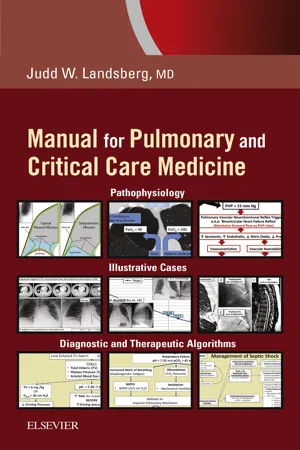
- 416 pages
- English
- ePUB (mobile friendly)
- Available on iOS & Android
Manual for Pulmonary and Critical Care Medicine E-Book
About this book
Clinical Practice Manual for Pulmonary and Critical Care Medicine, by Judd W. Landsberg, MD, is a unique point-of-care manual that provides essential information on managing inpatients and outpatients with common, serious respiratory and internal medicine presentation and problems. Easy-to-follow diagnostic and therapeutic algorithms are accompanied by case-based illustrations encountered on a daily basis by attendings, fellows, residents, and students. The bulleted format, concise approach, and familiar examples provide a framework for effective teaching, learning, and patient care.- Identifies common but important misconceptions that are regularly encountered in pulmonary and critical care training.- Uses a concise, bulleted format throughout, helping you find key information quickly.- Illustrates cases with primary data such as x-rays, monitor strips, ventilator wave forms, and other familiar documentation.- Helps you develop your ability to effectively explain your thought process in the clinical setting to other practitioners at the bedside.- Serves as a 'teachers guide' for clinician educators, organizing topics in an easy to teach fashion, amenable to 'chalk talks' and bedside didactics- Provides focused discussions of basic physiology and pathophysiology related to pulmonary and critical care medicine.
Frequently asked questions
- Essential is ideal for learners and professionals who enjoy exploring a wide range of subjects. Access the Essential Library with 800,000+ trusted titles and best-sellers across business, personal growth, and the humanities. Includes unlimited reading time and Standard Read Aloud voice.
- Complete: Perfect for advanced learners and researchers needing full, unrestricted access. Unlock 1.4M+ books across hundreds of subjects, including academic and specialized titles. The Complete Plan also includes advanced features like Premium Read Aloud and Research Assistant.
Please note we cannot support devices running on iOS 13 and Android 7 or earlier. Learn more about using the app.
Information
Approach to oxygenation, hypoxemia, and hypoxemic respiratory failure
Common misconceptions and mistakes
Oxygenation

Table of contents
- Cover image
- Title page
- Table of Contents
- Copyright
- Preface
- Dedication
- Acknowledgments
- Section I: Pulmonary
- Section II: Critical Care
- Index